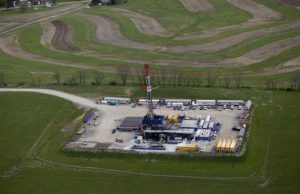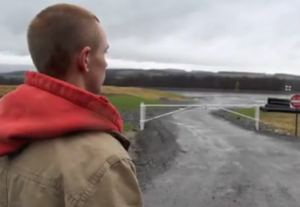Since the onset of the fracking boom almost a decade ago, every state in the US has been examining its geological resources in the hope of finding oil or gas it can access through this extraction method. Almost half the states are now producing at least some shale gas, with a few – Texas, Pennsylvania, California, Colorado, North Dakota – sitting on massive deposits.
Nearly half a million wells in the US were producing shale gas in 2012. But while many countries now seek to bolster their economies by following the American lead in exploiting this controversial new source of fossil fuels, campaigners in the US are warning of serious collateral damage to the environment: the depletion and contamination of vital water supplies.
The process of fracking, short for “hydraulic fracturing”, involves injecting water, sand and chemicals down vertical wells and along horizontal shafts − which can be several miles long − to open up small pores in the rock. This releases the methane for capture.
Fracking a well just once uses upwards of five million gallons of water, and each well can be fracked 18 times or more. Texas alone used an estimated 25 billion gallons of water for fracking in 2012, according to a recent report by Ceres, a not-for-profit group advising investors on climate change.
Demand accelerating
Where surface water is lacking, as in Texas, underground aquifers are being emptied at record rates. And while fracking’s water use still trails behind personal and agricultural uses, demand is accelerating even while much of the US is suffering extreme drought, which is probably caused or worsened by climate change exacerbated, ironically, by burning fossil fuels.
There is no overarching policy regulating how the industry uses water. In the Energy Policy Act of 2005, a provision known as the “Halliburton loophole” exempts oil and gas operations from almost all federal air and water regulations, leaving protection of these basic life necessities to the states.
Texas does not require operators to report groundwater use, but new regulations in California require operators to state where they will get their water and how they will dispose of their wastewater. Even in the face of a drought emergency, the state’s well operators still plan to take most of their water from surface sources, says Kyle Ferrar, California state co-ordinator of the Fractracker Alliance, a not-for-profit data analysis group.
Disposing of the water when fracking is complete is also challenging. The wastewater is a mixture of the injected freshwater, fracking chemicals, and deep formation water, which is usually briny and often mildly radioactive. It can’t be recycled for typical water uses, as few public drinking water or sewage treatment plants are equipped to remove fracking contaminants. In fact, some of these contaminants react with chlorine compounds to form trihalomethanes, which can cause liver and kidney damage.
The most reasonable wastewater solution appears to be re-using it in subsequent fracking operations − a practice that is growing in popularity among American well operators because it can reduce the amount of new water required. Waste can also be injected into spent oil and gas wells, much as CO2 is sequestered.
The US Environmental Protection Agency operates an underground injection control programme, which it administers directly in some states and allows state government to run in others. But many operators still pump the waste into large surface ponds lined with plastic, allowing the water to evaporate and carry some contaminants into the atmosphere. Storm runoff can also transmit wastewater from ponds and landfills to surface and groundwater systems.
Pennsylvania is struggling to balance its resources in the face of the fracking boom. In 2011, the Department of Environmental Protection asked the state’s gas well operators to stop discharging waste into surface waters. Because Pennsylvania’s geology is not conducive to stable injection wells, operators now ship much of their wastewater next door to Ohio, which encourages the practice as an income source.
Shady practices
In 2011, at least half the wastewater stored in Ohio came from out of state, according to the Environment Ohio Research & Policy Center. Many Ohio environmentalists object to taking other states’ waste − partly because the fracking boom has resulted in some shady practices.
“Dumping seems to be a really ongoing problem,” explains Julie Weatherington-Rice, senior scientist at Bennett & Williams Environmental Consultants in Ohio. “We’re seeing dumping down old mineshafts and dumping on roads where the spigot at the end of the tank is [allowed] to dribble all the way to the [disposal] well.”
In March, a Youngstown company admitted it had dumped thousands of gallons of waste into a stormwater sewer feeding into a river system. Testing revealed that the waste contained benzene, which is a known carcinogen, and toluene, a nervous system toxicant.
If concrete wellbores or seals at the wellhead are misaligned or corroded, methane and chemicals can migrate into potable water aquifers − something that the small town of Dimock, Pennsylvania, learned the hard way in 2009.
Most Dimock residents have individual water wells. Shortly after Cabot Oil and Gas began fracking in the area, a resident’s backyard water well exploded. After it was determined that Cabot’s operations were the source of the methane contamination, a consent agreement with the state required Cabot to supply Dimock’s drinking water.
But the state allowed Cabot to stop supplying water in 2011, without testing residents’ well water, according to a report by StateImpact, a project of National Public Radio stations.
Potable water
Because many residents still don’t have potable water as a result of the contamination, volunteers from around the state are holding local events to raise money to supply water to Dimock, says Karen Feridun, an activist with Berks Gas Truth, an anti-fracking group. The situation remains unresolved for the long term.
Although Pennsylvania and Texas have been hit especially hard by the effects of shale gas extraction, no part of the US is exempt.
Even the Pacific Northwest,long insulated from fossil fuel extraction and burning by virtue of its massive hydropower projects and deep layers of flood basalt covering any oil or gas-bearing formations, is now vulnerable.
The region faces the prospect of liquefied natural gas (LNG) pipelines and a massive increase in trains carrying oil and coal through the scenic Columbia River Gorge to west coast ports for shipment to China. LNG terminals are also being planned for gas shipment from the US east coast to Europe.
At some point, campaigners warn, all Americans may have to choose between energy and clean water.
“Make sure [fracking’s] not taking your drinking water or your irrigation or the water that your herds need to survive,” says Weatherington-Rice. “When this happens, you’ve lost that water forever.”
This article was first published by Climate News Network






